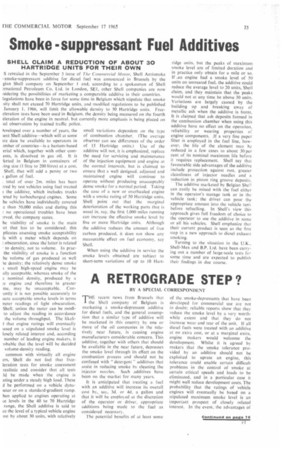Smoke -suppressant Fuel Additives
Page 75

If you've noticed an error in this article please click here to report it so we can fix it.
SHELL CLAIM A REDUCTION OF ABOUT 30 HARTRIDGE UNITS FOR THEIR OWN
S revealed in the September 3 issue of The Commercial Motor, Shell Antismoke .smoke-suppressant additive for diesel fuel was announced in Brussels by the gian Shell company on September 1 and, according to a spokesman of Shell :rnational Petroleum Co. Ltd. in London, SEI, other Shell companies are now tsidering the possibilities of marketing a comparable additive in their countries. tegulations have been in force for some time in Belgium which stipulate that smoke sity shall not exceed 70 Hartridge units, and modified regulations to be published January 1, 1966, will limit the allowable density to 50 Hartridge units. Freecleration tests have been used in Belgium. the density being measured on the fourth eleration of the engine in neutral. but currently more emphasis is being placed on Jai observation by trained traffic police.
leveloped over a number of years, the tent Shell additive—which will at some ire date be available to operators in trnber of countries—is a barium-based erial which, together with other coments, is dissolved in gas oil. It is keted in Belgium in containers of ting size (1 litre to 200 litres) at a cost. Shell, that will add a penny or two gallon of fuel.
, total of over 2m. miles has been :red by test vehicles using fuel treated t the additive, which includes trucks 'ered by turbocharged engines. Some be vehicles have individually covered c than 50,000 miles and during this ! no operational troubles have been trved, the company states.
he visibility of smoke is the main !ct that has to be considered; this plicates assessing smoke acceptability Is with a meter which depends on obscuration, since thd latter is related to density, not to volume. In practhe visibility of smoke is a function he volume of gas produced as well te density; the relatively dense smoke small high-speed engine may be ally acceptable. whereas smoke of the
e nominal density, produced by a :r engine and therefore in greater me, may be unacceptable. Conlently it is not possible accurately to uatc acceptable smoke levels in terms new readings of light obscuration. Shell, unless the meter can be modito adjust the reading in accordance the volume throughput. The likeli1 that engine ratings will eventually oased on a stipulated smoke level is loseiy related interest and, according number of leading engine makers, it tobable that the level will be decided volume-density reading.
common with virtually all engine crs, Shell do not feel that freeleration tests for smoke assessment realistic and consider that all tests Id be made when the engine is ating under a steady high load. These d be performed on a vehicle dynaleter or on a standard-gradient ramp. hen applied to engines operating at ce levels in the 40 to 70 Hartridge range, the Shell additive is said to cc the level of a typical vehicle engine ust by about 30 units, with relatively small variations dependent on the type of combustion chamber. (The average observer can see differences of the order of 15 Hartridge units.) Use of the additive will not, it is emphasized, replace the need for servicing and maintenance of the injection equipment and engine at the normal intervals, but is claimed to ensure that a well designed. adjusted and maintained engine will continue to operate without producing unacceptably dense smoke for a normal period. Taking the case of a new or overhauled engine with a smoke rating of 50 Hartridge units. Shell point out that the marginal deterioration of the working parts that is usual in. say. the first 1.000 miles running can increase the effective smoke level by five or more Hartridge units. Although the additive reduces the amount of free carbon produced. it does not show any measurable effect on fuel economy. say Shell.
When using the additive in service the smoke levels obtained are subject to short-term variations of up to 10 Hart ridge units, but the peaks of maximum smoke level are of limited duration and in practice only obtain for a mile or so. If .an engine had a smoke level of 50 units on untreated fuel, the additive could reduce the average level to 20 units, Shell claim, and they maintain that the peaks would not at any time be above 30 units. Variations are largely caused by the building up and breaking away of metallic ash when the additive is burnt. It is claimed that ash deposits formed in the combustion chamber when using this additive have no effect on the operation. reliability or wearing properties of engine components. if a very fine paper filter is employed in the fuel line, however. the life of the element may be reduced in a few cases to about 30 per cent of its nominal maximum life before it requires replacement. Shell say that favourable side advantages of the additive include protection against rust, greater cleanliness of injector needles and a reduction in piston ring groove deposits.
The additive marketed by Belgian Shel! can easily he mixed with the fuel either in the operator's storage tank or in the vehicle tank: the driver can pour the appropriate amount into the vehicle tank before refuelling. In Shell's view this approach gives full freedom of choice to the operator to use the additive in some or all his vehicles. Shell emphasize that their current product is seen as the first step in a new approach to diesel exhaust smoking.
Turning to the situation in the U.K.. Shell-Mex and B.P. Ltd. have been carrying out a number of large-scale tests fosome time and are expected to publish their findings in due course.




















































































































































































